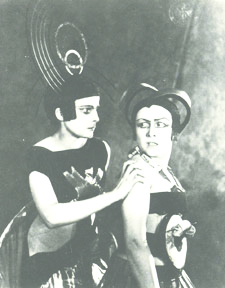
Wikipedia Commons
If dizzying scalene triangles, camel caravans, infants tied to high chairs or Soviet propaganda get your film-geek juices flowing, “Aelita” has some morsel of cinematic satisfaction to offer. “Some” is the keyword in that sentence.
The 1924 Russian silent film directed by Yakov Protazanov was screened Wednesday at the Whitney Humanities Center as part of the Yale Film Colloquium series, “Spaced Out: Outer Space and Altered States.” It featured a live performance of the Shostakovich score.
Now known as the first Russian science fiction movie and regarded for its costume and set design, “Aelita” toggles clumsily between erotic fantasy, domestic melodrama, escapism, propaganda and slapstick comedy. The number of such switches and their confusing diversity makes the film difficult to digest; one minute Los the engineer mixes rocket fuel, the next Aelita and her spouse Gol make out on Mars or a shirtless man crafts a sickle in front of “October 25th 1917” in flaming letters.
The film is subtitled “Queen of Mars” or “Revolt of the Robots,” the latter subtitle possibly a relevant allusion to the “robot,” or manual labor that Eastern European serfs owed nobles (thanks HIST 202: European Civilization, 1648-1945).
To a modern audience, like the smattering of elderly couples, angsty European Studies graduate students and one circa-eight-year-old girl who made respectable progress on a word-search during the screening, Aelita’s uncomfortable thematic acrobatics are almost funny. Weirder yet, the movie was a blockbuster in the USSR until being derailed by Soviet critics for alleged lackluster patriotism and buried until the Iron Curtain’s collapse.
The creative plot is worth a paragraph or two of your time. On Earth in communist Russia, Los the engineer and Natasha, a checkpoint employee, are happily married until ex-aristocrat Victor Ilrich moves in. Ilrich and Natasha become too close for Los, who frustratedly distances himself to build a rocket to Mars because why not. The domestic melodrama hits its apex when Los jealously shoots at Natasha and runs away, pursued by archetypal clumsy detective Kravtsov.
On Mars, a feudal society identical to tsarist Russia, Queen Aelita sees Los through a telescope and falls in love just in time for him to rocket up to her with arbitrary ex-soldier Gussev and, accidentally, Kravtsov in company. The intrepid cosmonauts inspire a proletarian revolution and create The Martian Union of Soviet Socialist Republics until Los wakes up from his daydream (surprise!) and realizes that domestic violence is wrong and instead of indulging in space-travel, he and every good comrade must fulfill their immediate duty to the USSR.
The intrigue of the movie to an open-minded 21st century viewer is its curious socio-political commentary, in the choices the film makes about showing certain aspects of Soviet life and its 34-million-miles-away reflection in outer space.
The little things get me interested. Ilrich takes Natasha to a secret high-society ball where ex-aristocratic women pull off bland, rationed snow boots to reveal black patent leather heels. Is this funny, critical, intriguing? Why is it part of the movie?
On tsarist Mars, the leaders pass a decree that condemns one third of the proletarian “robot” workforce to be frozen in refrigerators. There’s an incredible scene that lingers on the decree’s implementation: immobile “refrigerated” robots shoot down slides, one after another, while unfrozen worker-bee robots stack their lifeless bodies in storage. Wow. For a brief reflection on pre-communist Russia, limp bodies layered like spilled toothpicks is a pretty scathing critique. Then again, is there a nonscathing critique of serfdom? Did this scene upset people? Charge them up with Soviet pride? Were they just thought-provoked by the shiny constructivist costumes?
More satisfying, or a different breed of satisfying for us than for its original fans, are the video clips of normal people going about their lives in the USSR, of crowded trains and bustling city squares and orphanages (if you were wondering where the infants tied to high chairs came into play). A silent black-and-white film left costume designer Aleksandra Ekster little choice but to play with texture and print, so the Moscow we stare back a century into is chock full of furs and patterned jackets in contrast with metal-and-glass monochromatic Mars.
“Aelita” is uncomfortable and unsatisfying and wacky. Be it the tied-up babies or refrigerated robot slides, it’s also really fascinating. The movie makes us consider what judgements we make about Aelita and Los’s particularly steamy Martian hookup, and in the spirit of fairness, what judgements a review about “Bridesmaids” 93 years from now will make of us.
Emily Schussheim | emily.schussheim@yale.edu .







